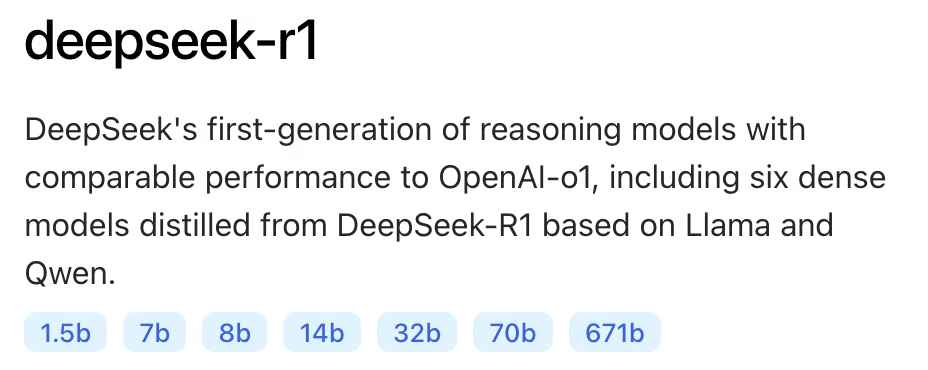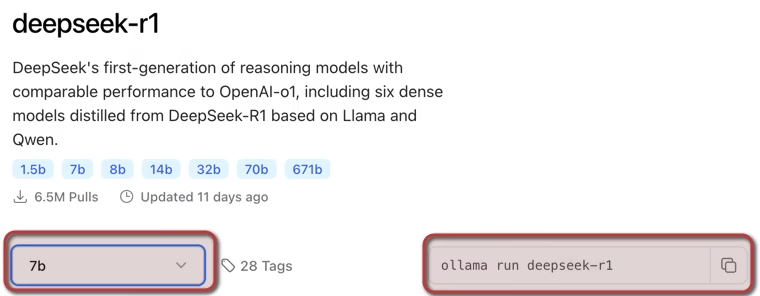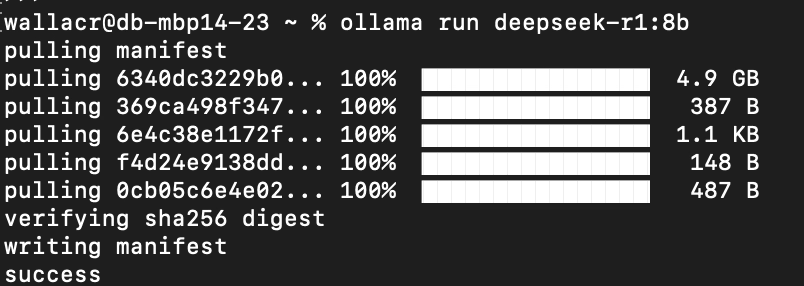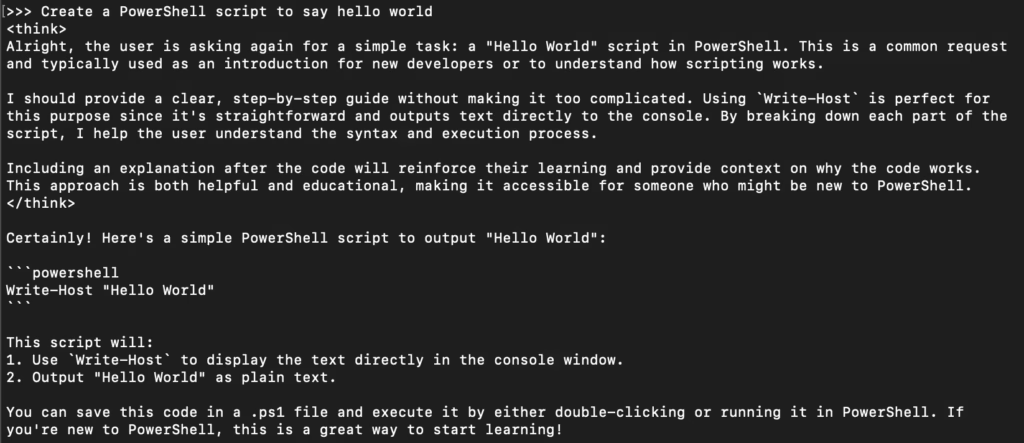In this article, I’ll introduce you to the DeepSeek-R1 LLM (Large Language Model), Ollama and how to install it locall on your Mac or PC. These instruction are put together using a Mac, but it’s more or less the same on a PC.
Introduction to DeepSeek-R1
DeepSeek-R1 is a high performing reasoning LLM (Large Language Model) created by Deepseek AI. This LLM is specifically for enhanced data retrieval and management. Utilising cutting-edge algorithms, it stands out in the realm of information extraction by providing users with the ability to efficiently search vast datasets. Whether employed in AI application or just utilised for traditional questions and management tasks, DeepSeek-R1 proves to be a vital asset for professionals seeking optimised solutions for complex searching challenges.
At its core, DeepSeek-R1 employs natural language processing techniques, which allow it to interpret user queries with greater accuracy than traditional search tools. This innovation not only improves the user experience but also increases the likelihood of retrieving relevant information swiftly. By leveraging this technology, DeepSeek-R1 can transform the way individuals and organizations access information, offering a seamless interface that simplifies intricate data searches.
One of the unique features of DeepSeek-R1 is its adaptability across various platforms, including Mac, PC and Linux. This cross-compatibility ensures that users can leverage the tool’s functionalities without being constrained by their operating system. Additionally, DeepSeek-R1 supports a range of data formats, further broadening the scope of its application in real-world scenarios.
Furthermore, DeepSeek-R1’s capabilities extend into the realm of AI-driven solutions, where it aids in predictive analytics and trend forecasting. This integrative functionality not only enhances decision-making but also supports businesses in deriving insights that drive strategic initiatives. Consequently, the advantages offered by DeepSeek-R1 position it as an indispensable tool for researchers, data analysts, and business professionals alike, paving the way for innovative approaches to data interaction and retrieval.
What I love the most about Deepseek-R1, is that it thinks out loud, and you can see it processing your request, considering ways to answer etc. I tried to bypass it’s rules, and it was really interesting watching it think about what I was trying to do.

Understanding Ollama
Ollama serves as an innovative tool designed to simplify the installation and management of AI models across various platforms, including Mac and PC. When installed, you can access your installed LLMs via a terminal window.
One of the primary benefits of Ollama is its ability to manage dependencies, which are essential components for running AI models smoothly. By taking care of these dependencies, Ollama reduces the likelihood of encountering compatibility issues that often arise during the software installation process. This feature is particularly useful for users who may not possess extensive technical knowledge, as it alleviates the need for deep understanding of underlying frameworks or libraries.
In addition to managing dependencies, Ollama enables automatic updates for installed AI models, ensuring that users always have access to the latest features and improvements. This aspect is vital in the rapidly evolving domain of artificial intelligence, where new advancements are frequently introduced. Moreover, by maintaining current software versions, Ollama enhances the overall user experience, providing a seamless transition when employing models like DeepSeek-R1.
Why Run DeepSeek-R1 Locally?
Running DeepSeek-R1 locally on your Mac or PC offers numerous advantages compared to relying on cloud services. One of the most significant benefits is the improved performance that local installations typically provide. By utilising your own hardware’s processing power, you can achieve faster processing times and more efficient data handling. This is particularly beneficial when working with large datasets or performing computation-heavy tasks, minimising latency that can occur with cloud-based systems.
Another key advantage of local execution is enhanced control over your data. When running DeepSeek-R1, or any model for that matter, on your own machine, you are not subject to external storage or transfer protocols, which means that you can maintain better control over your data environment. This is especially important for organizations dealing with sensitive information where data integrity and confidentiality are paramount.
Privacy is a further consideration that significantly outweighs the typical downsides of local versus cloud solutions. By maintaining data on-premises, you significantly reduce the risk of unauthorised access that often accompanies cloud services. Local installations of DeepSeek-R1 ensure that your data remains secure within your own network, thus mitigating potential privacy breaches and gaining peace of mind in managing sensitive information.
There is also the financial aspect, as running it locally will cost you nothing, other than the cost of your machine and electricity that is.
Pre-requisites for Installation
Before embarking on the installation of DeepSeek-R1 using Ollama, it is essential to ensure that your system meets the necessary prerequisites for a smooth setup. Both Mac and PC users must take into account specific system requirements that facilitate the effective functioning of DeepSeek-R1. For Mac users, the minimum requirements include macOS version 10.15 (Catalina) or higher, with at least 8 GB of RAM and a modern multi-core processor. In contrast, PC users are advised to operate on a Windows 10 (64-bit) platform or later, similarly equipped with a minimum of 8 GB of RAM and a multi-core processor.
Next, the installation of Ollama is a critical step in this process. To utilize DeepSeek-R1 effectively, users must install Ollama on their systems. This tool serves as the essential bridge enabling DeepSeek-R1’s functionalities. For Mac installations, Ollama can be obtained via Homebrew, a popular package manager. Users should open the terminal and execute the command: brew install ollama. For Windows users, Ollama can be downloaded directly from the official website, ensuring that you select the correct version for your operating system.
In addition to software installations, users should verify that they have appropriate configurations set up in their system. This includes confirming the availability of Python (preferably version 3.8 or higher) since many functionality aspects of DeepSeek-R1 rely on it. You can download Python from the official Python website and follow the provided installation guidelines. Furthermore, ensuring that system paths are correctly set will facilitate seamless operation with both DeepSeek-R1 and Ollama. Once these prerequisites are met, users will be well-prepared to initiate the installation process for DeepSeek-R1, ensuring optimal performance from the outset.
Step-by-step Deepseek-R1 installation guide for your local computer
Installing DeepSeek-R1 on your computer is simple. Visit the Ollama website and download the version that matches your machine.
On a PC, run the installer. On a Mac, extract the application from the zip file and drag it to your Applications folder.
Ollama is now installed, so you can run a terminal window (Mac or PC).
To install the Deepseek-R1 LLM, you need to decide on a version:

The lower the number, the smaller the size and the less it’s capabilities, but you’ll be surprised with how good the smallest model is. The higher the number, the larger the model and the more resourcecs you need to make the most of it.
7b is the default model, and is perfect good for general use.
To install the model, visit https://ollama.com/library/deepseek-r1 and select you preferred model, copy the install code and paste it into your terminal window:

The below example shows the 8b model being installed:

Now all you have to do is wait for it to install, and you will see a success message when it’s done.
Verifying Your Installation
As soon as Deekseek-R1 is installed, you will see three chevrons (>>>) indicating that you can start askign the LLM questions. So just type away, ask it what you want and experiment.

It really is that simple. If you close the terminal, just run the exact same install command to load the model, and if there’s an update, you’ll download and install the update.
Conclusion and Further Resources
In conclusion, the installation of DeepSeek-R1 can run on both Mac and PC platforms using Ollama’s streamlined installation and update process. This guide has illustrated the few and simple steps required to install DeepSeek-R1.
If you have limited experience with LLMs, keep in mind that this is a more raw model than the likes of ChatGPT, so you will have to be really specific with your requests, and most likely create a RAG (Retrieval Augmented Generation) to increase relavance and reduce hallucinations.
Additionally, several online communities exist where users can discuss best practices, share use cases, and troubleshoot any challenges they encounter. Platforms like GitHub or specialised discussion boards can be instrumental in connecting with others who are using DeepSeek-R1, enabling a sharing of knowledge and collaborative problem-solving.
Frequently Asked Questions
1) What are the system requirements for installing DeepSeek-R1 using Ollama?
Answer: To successfully install DeepSeek-R1 using Ollama, ensure your system meets the following requirements:
- Operating System: Mac OS X 10.15 or later, or Windows 10/11.
- Processor: A 64-bit processor with at least 4 cores; an 8-core processor is recommended for optimal performance.
- Memory (RAM): A minimum of 16 GB is required, though 32 GB is recommended to handle large datasets efficiently.
- Storage: At least 10 GB of free disk space for the installation and additional space for data storage.
- Internet Connection: A stable internet connection is necessary for downloading Ollama and DeepSeek-R1 packages, as well as for any updates.
Meeting these requirements will help ensure a smooth installation and optimal performance of DeepSeek-R1 on your system.
2) What should I do if I encounter errors during the installation of DeepSeek-R1 using Ollama?
Answer: If you experience issues during the installation process, consider the following troubleshooting steps:
- Verify System Requirements: Ensure your system meets the necessary specifications outlined above.
- Check Internet Connectivity: A stable internet connection is essential for downloading installation files.
- Review Error Messages: Carefully read any error messages displayed during installation; they often provide clues to the problem.
- Consult Official Documentation: Visit the official Ollama and DeepSeek-R1 documentation for guidance on common installation issues.
- Seek Community Support: Engage with user forums or communities related to Ollama and DeepSeek-R1, where experienced users may offer solutions.
- Contact Support: If problems persist, reach out to the support teams of Ollama or DeepSeek-R1 for professional assistance.
By following these steps, you can effectively address and resolve common installation challenges.
